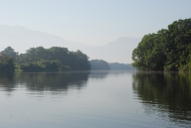
 |
Pico Bonito is a mountain park rising abruptly from the Caribbean sea. There is a lowland salt-water marsh refuge, Cuero y Salado, more or less between Pico Bonito and the sea. We took a day and went out there to see what we could see. Cuero y Salado is named for two rivers, the Cuero and the Salado, which come together at the coast and then immediately empty into the sea. There is a large estuary near the mouth of the rivers.
The refuge is accessed via a small train, "burra" in Spanish, once used to bring workers to a banana plantation but now used for tourists and as local transportation for the small farmers who live in the area. While hauling a load of touristas out to the Visitors' Center for the refuge, our train picked up cans of milk and dropped off empties, and gave local school-kids rides for free.
Cuero y Salado is home to howler and white-faced monkeys, approximately 195 species of birds, manatees, crocodiles, and jaguars on occasion. It is a privately administered refuge; I'm not sure how that works in Honduras.
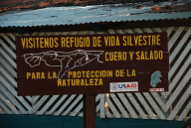 |
 |
 |
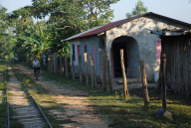 |
 |
| Cuero y Salado
Entrance Sign |
The Way In | Tracks
(as Sidewalk) |
Train Cart |
 |
 |
| Switchyard... | Milk Delivery |
We saw loads of birds from the train on the way in; mostly egrets, wading birds and hawks. Our list included: Green Heron, Little Blue Heron, Tiger Heron, Yellow Crowned Night Heron, Purple Gallinule, Wood Stork, Snowy Egret, White Ibis, Limpkin, Black-bellied Whistling Duck, Blue Winged Teal, Black Vulture, Roadside Hawk, Lesser Nighthawk, Ruddy Ground Dove, Green Kingfisher, Ringed Kingfisher, Northern Jacana, Great Potoo, Black-headed Trogon, Neotropical Cormorant, Long billed Hermit (we only heard it...), Ivory-billed Woorcreeper (sounds kinda like a Canyon Wren, heard only)
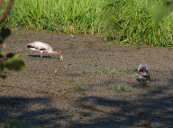 |
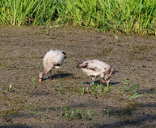 |
 |
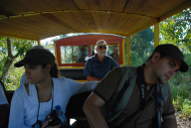 |
| Wood Stork | Wood Stork | Snowy Egret | Inside View |
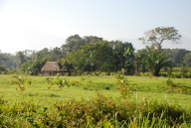 |
| Countryside from Train |
The train ends at a small visitors' center on the bank where the rivers come together near their mouth. From there we got in a small launch and motored up into the estuary and up the river.
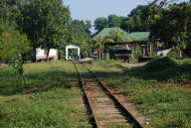 |
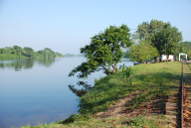 |
 |
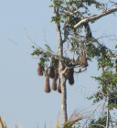 |
| End of the Line | Looking
towards Caribbean |
Looking Inland
(Upstream) |
Oropendola Nests
|
There were iguanas hanging out in some of the trees. I also wrote down that we saw a "biting gaited squirrel," whatever the heck that is. Anyone ever heard of a gaited squirrel??? I didn't think so... In addition, it says here we saw a Sapaton, a tree with a huge flower with roundish fruits which squirrels eat. I presume those are the biting gaited ones... Unfortunately, I didn't get a picture of either of those. The only reference to a Sapaton tree I can find is on a list of endangered trees and shrubs, and it's listed as endangered in Cuba.
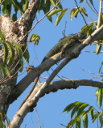 |
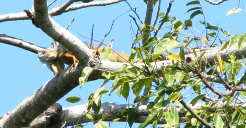 |
| Green Iguana
|
Green Iguana
|
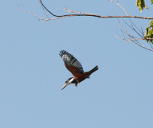 |
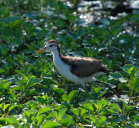 |
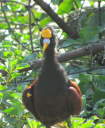 |
| Kingfisher | Northern Jacana | Northern Jacana
|
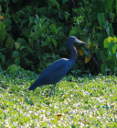 |
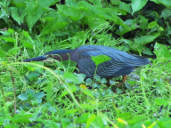 |
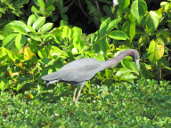 |
 |
| Little Blue Heron | Little Blue Heron
|
Little Blue Heron
|
Immature
Yellow Crowned Night Heron |
We found a Blue Morpho butterfly on its last legs in the water, so we "saved" it and got a few photos, but it eventually died. We also found a bunch of small bats roosting on a tree in a swampy backwater.
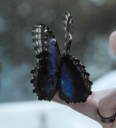 |
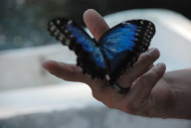 |
 |
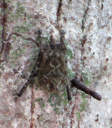 |
| Blue Morpho | Blue Morpho | XXX Bats | XXX Bats
|
We went up the estuary to where the trees arching overhead closed in on us; it got noticeably darker with the sun blocked out. There were vines dangling everywhere, and birds twittering away which were impossible to see.
 |
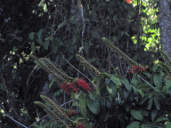 |
| Overhanging Jungle River
|
Blossoms on River
|
After much searching, we found howler monkeys in several places along the river; they dutifully howled for us.
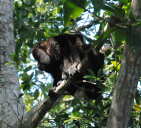 |
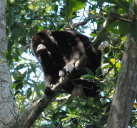 |
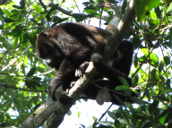 |
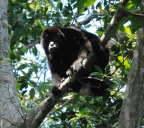 |
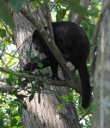 |
| Howler Monkey | Howler Monkey | Howler Monkey
|
Howler Monkey | Howler Monkey |
After some refreshments in the Visitors' Center, we hopped back on the train for the ride out.
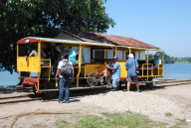 |
| Train |